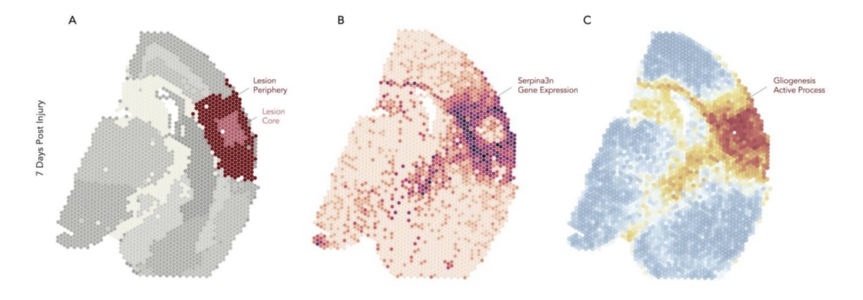Groundbreaking study maps brain’s recovery process after stroke using spatial transcriptomics
Thu Nov 07 09:50:55 CET 2024
Thu Nov 07 09:50:55 CET 2024 | Thu Nov 07 09:50:55 CET 2024 - Thu Nov 07 09:50:55 CET 2024

A team of scientists from the Institute of Biotechnology of the Czech Academy of Sciences (IBT CAS) and the Institute of Experimental Medicine of the Czech Academy of Sciences (IEM CAS), supported by colleagues at the Institute for Clinical and Experimental Medicine (IKEM), has made significant strides in understanding how the brain recovers after a stroke. Published this week in the prestigious journal Proceedings of the National Academy of Sciences (PNAS), the study employs cutting-edge spatial transcriptomics to create a detailed map of the molecular and cellular responses of glial cells – cells essential for brain health – during the critical first week following an ischemic stroke in a pre-clinical mouse model.
The study emphasizes the potential of spatial transcriptomics to uncover intricate details about the brain’s recovery processes. “Spatial transcriptomics allows us to see not just which genes are active, but precisely where they are active within the brain,” said Daniel Zucha, the main author of the study from IBT CAS. “Using a pre-clinical stroke model, this spatial context is crucial for understanding the complex interactions during stroke recovery and opens up exciting possibilities for deeper insights into the recovery process.”
By mapping gene expression patterns in their exact locations, the researchers discovered how glial cells like astrocytes, microglia, and particularly oligodendrocytes, enter activated states that vary depending on their proximity to the injury site. “Understanding the spatial dynamics of glial cell activation helps us understand how the brain limits damage and promotes recovery,” commented Dr. Miroslava Anderova, a senior author from IEM CAS. “The glial scar is not just a barrier but a dynamic environment where crucial cell-to-cell communication occurs.”
 Key components of the cellular response to stroke
Key components of the cellular response to stroke
The study also reveals how different cell types contribute uniquely to the glial scar, particularly highlighting the role of oligodendrocytes in modulating inflammation and fostering recovery. Dr. Lukas Valihrach, a senior author from IBT CAS, noted, “Our findings highlight the active role of oligodendrocytes in this process, suggesting that they play a more involved role in recovery than previously thought.” This adds new understanding to the diverse functions of glial cells beyond passive support of neuronal cells.
Supported by the Czech Science Foundation (GACR), this research not only deepens our understanding of stroke pathobiology but also highlights the transformative potential of spatial transcriptomics in neuroscience research. The team plans to build on these findings with future study using human ischemic samples, bringing this line of research closer to possible clinical applications for stroke recovery.
Original article: https://www.pnas.org/doi/10.1073/pnas.2404203121
